 Gilman Studio On-Line Lessons
Gilman Studio On-Line Lessons
Yang Style Long Form
Tai Chi Chuan
This Lesson Contains:
Movement # 46 – Turn And Chop Opponent With Fist
This movement is very similar to Movement # 32 (same name), only this one starts with the opponent grabbing from behind. I turn and deliver an elbow strike to his center, follow with a right back fist, and end with a right palm strike. This clearly illustrates the principle of continuing the attack, like one wave following another. We don’t want to let the opponent obtain a root and find his center.
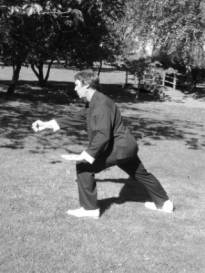
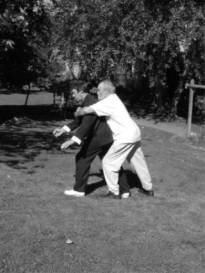 Following Punch Downward, John grabs me from behind.
Following Punch Downward, John grabs me from behind.

 In the first picture I am starting to shift the weight back onto the right foot, and the torso is turning to the right. The left toe is raised so I can pivot on the heel and turn the toe to face south. The hands stays pretty much the same. The right hand remains in a fist and starts to pull upwards toward the chest level. The left hand relaxes and moves up and to the right, following the right fist.
In the first picture I am starting to shift the weight back onto the right foot, and the torso is turning to the right. The left toe is raised so I can pivot on the heel and turn the toe to face south. The hands stays pretty much the same. The right hand remains in a fist and starts to pull upwards toward the chest level. The left hand relaxes and moves up and to the right, following the right fist.
In the second picture I have completed the elbow strike. The weight has shifted onto the right foot and the left toe has completed its turn to face south. Sink deeply into the right Kua so you won’t overextend. The torso faces south. The right fist is held close to the center of the chest with the left palm facing the fist. It is there to add force if necessary. See the next pictures.
Focus on the right elbow for striking.
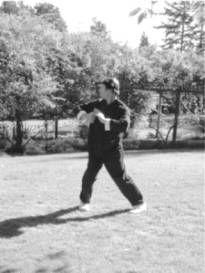
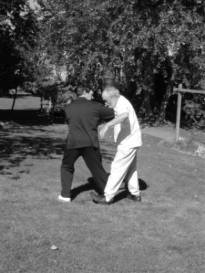 Notice the placement of the two hands. The right fist is held close with the back of the hand facing outward. The left palm faces this fist. The power for this movement comes from the left leg. Be sure to keep a firm root on the left foot. The left toe is turned inward in order to create a more solid base of support.
Notice the placement of the two hands. The right fist is held close with the back of the hand facing outward. The left palm faces this fist. The power for this movement comes from the left leg. Be sure to keep a firm root on the left foot. The left toe is turned inward in order to create a more solid base of support.
This is a very strong and dangerous movement. The elbow is harder, sharper, and can deliver more power then the fist. When aimed at the solar plexus, this strike can be fatal.
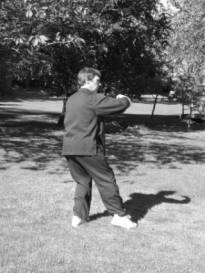 I am now starting to deliver a quick back fist strike with the right hand.
I am now starting to deliver a quick back fist strike with the right hand.
The weight shifts to the left foot in order to free up the right leg. The right leg opens to the right, as the torso turns right.
The right back fist strike is delivered by snapping out the fist, pivoting at the elbow. The power comes from the turning of the torso. The left hand remains in the left center part of the chest.
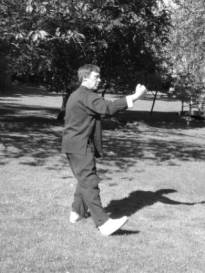
 The strike is completed.
The strike is completed.
The right foot steps out, touching the heel. The toe faces slightly to the right of west. The weight stays on the left foot. It is easy to shift the weight onto the right foot at his point, but that is incorrect.
The back fist completes its arc with a downward motion, ending on the right side of the body at the nose level. The left hand is still relaxed on the left side of the chest.
Focus on the right back fist.
Usually when I do this movement, I try and step to the right of the opponent’s left foot to make a better base of support. In the picture of the strike I have used a sweep with the right foot to upset John’s root and concentration.
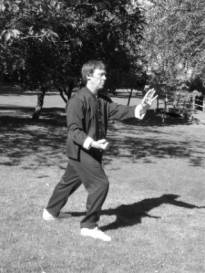
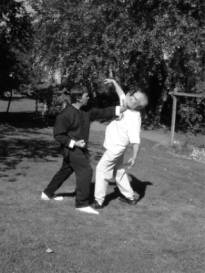 I finish with a left palm strike.
I finish with a left palm strike.
The weight shifts to the right foot and the torso turns to the right. The right toe, knee, and torso all face slightly to the right of west.
The left palm extends outward to end at the upper chest level on the left center side of the body. The right fist has pulled down to the waist level with fingers upward. The two arms work in unison – the right fist pulls back and the left arm strikes out together, balancing the force.
Focus on the left palm for striking.
Note: This and all movements are done in a slow, consistent fashion. There are no stops, or places where the movement goes slower or faster. It is like a great river running to the sea. Each part of this movement is easy to do. The hard part is to keep a relaxed flow.
